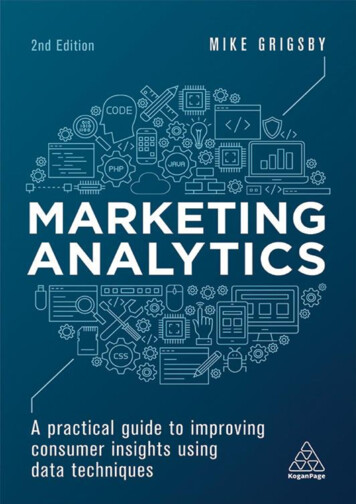
Transcription
PRAISE FOR MARKETING ANALYTICS‘With its focus on practicality, this book is an invaluable toolkit offrameworks to drive consumer-centric analytics initiatives acrossmarketing organizations. It is unique in going beyond theoretical aspectsand helping practitioners apply analytics to understand consumerbehaviour and identify business opportunities. Grigsby’s extensiveexperience makes it a must-read for marketing professionals of alllevels.’ Anna Andrusova, Senior Data Analyst, JCPenney‘This is an excellent read for people in the industry who work in strategyand marketing. It is one of the first books that I have read that covers theentire spectrum from demand, segmentation, targeting, and how resultscan be calculated. In an age where marketing is becoming more andmore sophisticated, this book provides the tools and the mathematicsbehind the facts. Marketing Analytics is written with a scientific voice, butis very readable, with the science wrapped into everyday activities,based on a character we can all relate to, that are derived from theseformulas, ultimately driving ROI.’ Elizabeth Johnson, CEO,PathFormance‘Grigsby’s book is the right blend of theory applied to the real-worldlarge-scale data problems of marketing. It’s exactly the book I wish I’dhad when I started out in this field.’ Jeff Weiner, Senior Director,Analytics, One10‘An insightful, practical book for analytics marketing practitioners. Itboth entertains and serves as a handbook for marketing analytics. Witheasy-to-follow examples, Grigsby paints a clear picture of how toexecute data analytics and its role in the larger marketing andorganizational goals.’ Craig Armstrong, Director, Strategic BusinessAnalysis, Targetbase‘This is a great book for practitioners who have learned plenty oftheories and want to learn how to apply methodologies. It is also a great,easy-to-read resource for anyone who does not have a deep theoreticalbackground but wants to learn how analytics work in real life.’ IngridGuo, VP, Analytics, and Managing Director, Javelin Marketing Group(Beijing)
‘In Marketing Analytics, Mike Grigsby takes passionate marketingstrategists on a practical, real-life journey for solving common marketingchallenges. By combining the concepts and knowledge areas ofstatistics, marketing strategy and consumer behaviour, Grigsbyrecommends scientific and innovative solutions to common marketingproblems in the current business environment. Every chapter is aninteresting journey for the reader.What I like most about the book is its simplicity and how it applies toreal work-related situations in which almost all of us have been involvedwhile practising marketing of any sort. I also like how the author talksabout tangible measurements of strategic recommended marketingsolutions as well as how they add value to companies’ strategicendeavours. I highly recommend reading this book as it adds acompletely new dimension to marketing science.’ KristinaDomazetoska, Project Manager and Implementation Consultant atInsala – Talent Development and Mentoring Solutions‘Marketing Analytics, second edition is a must-read for students andbudding analytics professionals. The book illustrates concepts instatistics and marketing with real-world examples and providessolutions without getting too technical. It begins with basic statisticalconcepts required in the field of marketing analytics, then illustrates theapplication of these concepts to real-world business problems. It alsotouches upon concepts of big data analytics and, most importantly, whatreally IS an insight. This book is extremely conversational andentertaining to read and I’ve found myself reaching for it on multipleoccasions when I’ve encountered various marketing-analytics-relatedproblems, during both my student and professional life.’ Akshay Kher,Analytics Practitioner
Second EditionMarketing AnalyticsA practical guide to improvingconsumerinsightsusingdatatechniquesMike Grigsby
Publisher’s noteEvery possible effort has been made to ensure that theinformation contained in this book is accurate at the time of goingto press, and the publisher and author cannot accept responsibilityfor any errors or omissions, however caused. No responsibility forloss or damage occasioned to any person acting, or refraining fromaction, as a result of the material in this publication can beaccepted by the editor, the publisher or the author.First published in Great Britain and the United States in 2015 byKogan Page Limited as Marketing Analytics: A practical guide to realmarketing scienceSecond edition published in 2018Apart from any fair dealing for the purposes of research or privatestudy, or criticism or review, as permitted under the Copyright,Designs and Patents Act 1988, this publication may only bereproduced, stored or transmitted, in any form or by any means, withthe prior permission in writing of the publishers, or in the case ofreprographic reproduction in accordance with the terms and licencesissued by the CLA. Enquiries concerning reproduction outside theseterms should be sent to the publishers at the undermentionedaddresses:2nd Floor, 45 Gee StreetLondon EC1V 3RSUnited Kingdomc/o Martin P Hill Consulting122 W 27th St, 10th FloorNew York NY 10001USA4737/23 Ansari RoadDaryaganj
New Delhi 110002Indiawww.koganpage.com Mike Grigsby, 2015, 2018The right of Mike Grigsby to be identified as the author of this workhas been asserted by him in accordance with the Copyright, Designsand Patents Act 1988.ISBN 978 0 7494 8216 9E-ISBN 978 0 7494 8217 6Typeset by Integra Software Services, PondicherryPrint production managed by JellyfishPrinted and bound by CPI Group (UK) Ltd, Croydon, CR0 4YY
CONTENTSCoverTitle PageCopyrightContentsList of FiguresList of TablesForeword to the first editionForeword to the second editionPrefaceIntroduction to marketing analyticsPART ONEyou?Overview – how can marketing analytics help01 A brief statistics reviewMeasures of central tendencyMeasures of dispersionThe normal distributionConfidence intervalsRelations among two variables: covariance andcorrelationProbability and the sampling distributionConclusionChecklist: You’ll be the smartest person in the roomif you 02Brief principles of consumer behaviour and marketingstrategyIntroductionConsumer behaviour as the basis for marketingstrategyOverview of consumer behaviourOverview of marketing strategyConclusion
Checklist: You’ll be the smartest person in the roomif you 03 What is an insight?IntroductionInsights tend not to be used by executivesIs this an insight?So, what is an insight?Ultimately, an insight is about action-abilityChecklist: You’ll be the smartest person in the roomif you PART TWO Dependent variable techniques04What drives demand? Modelling dependent variabletechniquesIntroductionDependent equation type vs inter-relationship typestatisticsDeterministic vs probabilistic equationsBusiness caseResults applied to business caseModelling elasticityTechnical notesHighlight: Segmentation and elasticity modelling canmaximize revenue in a retail/medical clinic chain:field test resultsAbstractThe problem and some backgroundDescription of the datasetFirst: segmentationThen: elasticity modellingLast: test vs controlDiscussionConclusionChecklist: You’ll be the smartest person in the roomif you 05 Who is most likely to buy and how do I target them?
IntroductionConceptual notesBusiness caseResults applied to the modelLift chartsUsing the model – collinearity overviewVariable diagnosticsHighlight: Using logistic regression for market basketanalysisAbstractWhat is a market basket?Logistic regressionHow to estimate/predict the market basketConclusionChecklist: You’ll be the smartest person in the roomif you 06 When are my customers most likely to buy?IntroductionConceptual overview of survival analysisBusiness caseMore about survival analysisModel output and interpretationConclusionHighlight: Lifetime value: how predictive analysis issuperior to descriptive analysisAbstractDescriptive analysisPredictive analysisAn exampleChecklist: You’ll be the smartest person in the roomif you 07 Panel regression – how to use a cross-sectional time seriesIntroductionWhat is panel regression?
Panel regression: detailsBusiness caseInsights about marcom (direct mail, e-mail and SMS)Insights about time period (quarters)Insights about cross sections (counties)ConclusionChecklist: You’ll be the smartest person in the roomif you 08Systems of equations for modelling dependent variabletechniquesIntroductionWhat are simultaneous equations?Why go to the trouble of using simultaneousequations?Desirable properties of estimatorsBusiness caseConclusionChecklist: You’ll be the smartest person in the roomif you PART THREE Inter-relationship techniques09What does my (customer) market look like? Modellinginter-relationship techniquesIntroductionIntroduction to segmentationWhat is segmentation? What is a segment?Why segment? Strategic uses of segmentationThe four Ps of strategic marketingCriteria for actionable segmentationA priori or not?Conceptual processChecklist: You’ll be the smartest person in the roomif you 10 Segmentation – tools and techniques
OverviewMetrics of successful segmentationGeneral analytic techniquesBusiness caseAnalyticsComments/details on individual segmentsK-means compared to LCAHighlight: Why go beyond RFM?AbstractWhat is RFM?What is behavioural segmentation?What does behavioural segmentation provide that RFM does not?ConclusionSegmentation techniquesChecklist: You’ll be the smartest person in the roomif you PART FOURmarketingMore important topics for everyday11 Statistical testing – how do I know what works?Everyone wants to testSample size equation: use the lift measureA/B testing and full factorial differencesBusiness caseChecklist: You’ll be the smartest person in the roomif you 12 Implementing Big Data and Big Data analyticsIntroductionWhat is Big Data?Is Big Data important?What does it mean for analytics? For strategy?So what?Surviving the Big Data panicBig Data analyticsBig Data – exotic algorithmsConclusion
Checklist: You’ll be the smartest person in the roomif you PART FIVE Conclusion13 The finale – what should you take away from this?What things have I learned that I’d like to pass on toyou?What other things should you take away from allthis?GlossaryBibliography and further readingIndexBackcover
List of FiguresFIGURE 1.1Home sales pricesFIGURE 1.2Standard deviationFIGURE 4.1Actual and predicted unit salesFIGURE 5.1Actual events and logisticsFIGURE 5.2Lift chartFIGURE 6.1General survival curveFIGURE 6.2Survival analysisFIGURE 9.1Levels of consumer behaviourFIGURE 10.1CHAID outputFIGURE 10.2Hierarchical clustering – dendogramFIGURE 10.3Significant variablesFIGURE 10.4% of market vs % of revenueFIGURE 11.1Z-scoresFIGURE 12.1Example of a neural networkFIGURE 12.2Example of a support vector machine
List of TablesTABLE 1.1VarianceTABLE 1.2Covariance and correlationTABLE 4.1Demand model dataTABLE 4.2Ordinary regressionTABLE 4.3Quarterly modelTABLE 4.4Regression outputTABLE 4.5Elasticity, inelasticity, and total revenueTABLE 4.6Average price and ad spendTABLE 4.7Serial correlationTABLE 4.8Serial correlationTABLE 4.9Elasticity modellingTABLE 4.10Elasticity modellingTABLE 4.11Further elasticity modellingTABLE 4.12Further elasticity modellingTABLE 4.13Further elasticity modellingTABLE 5.1Simplified datasetTABLE 5.2Co-efficient outputTABLE 5.3Confusion matrixTABLE 5.4New variablesTABLE 5.5Updated confusion matrixTABLE 5.6Variance
TABLE 5.7Probability to purchaseTABLE 5.8Associated probabilitiesTABLE 6.1Final desktop model, liferegTABLE 6.2Time to event (in weeks)TABLE 6.3Three model comparisonTABLE 6.4Comparison of customers from differentbehavioural segmentsTABLE 6.5Results of survival modellingTABLE 6.6LTV calculationsTABLE 7.1Panel data structureTABLE 7.2Coefficients on marcom: random effectsTABLE 7.3Coefficients on marcom: fixed effectsTABLE 7.4Quarterly seasonalityTABLE 7.5Cross-sectional analysisTABLE 8.1Model resultsTABLE 10.1Segmenting algorithms comparedTABLE 10.2Bayes Information CriterionTABLE 10.3Bayes Information Criterion: second modelTABLE 10.4List of variables removedTABLE 10.5General view of six segmentsTABLE 10.6Details by segmentTABLE 10.7Additional details by segmentTABLE 10.8KPIs
TABLE 10.9Customer totalsTABLE 11.1Testing discounts against different audiencesTABLE 11.2 Testing discounts against different audiences ina 16 cell matrixTABLE 11.3Multiple sources model
Test banks, datasets and PowerPoint lecture slides relating to chapters are availableonline at: www.koganpage.com/MarketingAnalytics2
FOREWORD TO THE FIRST EDITIONIn Marketing Analytics Mike Grigsby provides a new way ofthinking about solving marketing and business problems, with apractical set of solutions. This relevant guide is intended forpractitioners across a variety of fields, but is rigorous enough tosatisfy the appetite of scholars as well.I can certainly appreciate Mike’s motivations for the book. Thisbook is his way of giving back to the analytics community byoffering advice and step-by-step guidance for ways to solve someof the most common situations, opportunities, and problems inmarketing. He knows what works for entry, mid-level, and veryexperienced career analytics professionals, because this is thekind of guide he would have liked at these stages.While Mike’s education includes a PhD in Marketing Science, healso pulls from his vast experiences from his start as an Analyst,through his journey to VP of Analytics, to walk the readerthrough the types of questions and business challenges we face inthe analytics field on a regular basis. His authority on the subjectmatter is obvious, and his enthusiasm is contagious, and bestcaptured by my favourite sentence of his book: ‘Now let’s look atsome data and run a model, because that’s where all the fun is.’What this education and experience means for the rest of
organizational goals.’ Craig Armstrong, Director, Strategic Business Analysis, Targetbase ‘This is a great book for practitioners who have learned plenty of theories and want to learn how to apply methodologies. It is also a great, easy-to-read resource for anyone who does not have a deep theoretical











